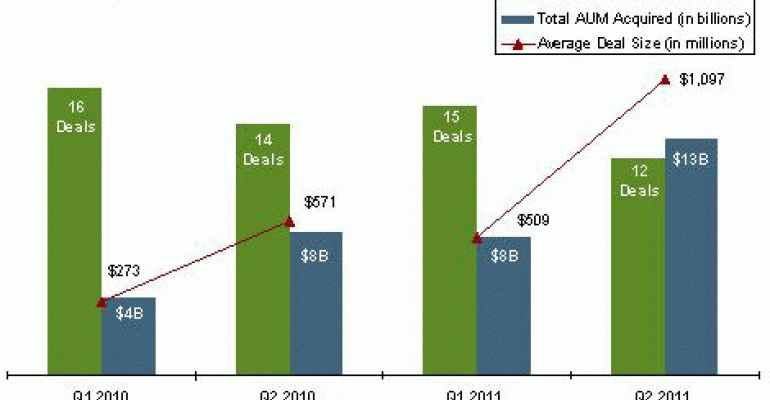Two industry experts expect merger and acquisition activity involving registered investment advisors will drop this year if the current volatility in the stock market stretches into the coming months. Charles Schwab’s RIA unit, Schwab Advisor Services, reported M&A deals were down slightly in the first half of 2011 year over year, but deal size as measured by assets under management was sharply higher. Yet the contortions of the market this month—the Standard & Poor’s 500 Index was down as much as 5 percentinintraday trading Thursday—may lead financial advisors to postpone dealmaking at least in the short term.
“For better or for worse, this is probably more impacted by the market than you’d like,” says Bing Waldert, an analyst with Cerulli Associates in Boston. “If you go into a period of more volatility, firms will put their strategic issues on hold to handhold their clients.” If markets stabilize, he adds, deals will probably return to the levels of the first half of the year.

David DeVoe, Schwab’s managing director of strategic business development, said he expects the M&A activity to grow over the next five to seven years, although he agrees that the current market turmoil would take some steam out of practice sales if it goes on for several months. RIAs are finding strong strategic reasons for buying and selling practices now, he says.
“The fact that RIAs are the dominant buyer category in 2011, I think, underscores the growing sophistication of RIA principals in mergers and acquisitions,” DeVoe says. “What we’ve seen over the past five or so years is the principals of RIAs getting a better understanding of the fundamentals of mergers and acquisitions, becoming curious about how mergers and acquisitions can better help them achieve their goals and objectives. They’re no longer just acquiring to acquire assets or clients. In some cases they’re acquiring to add a new capability to their company, or expand their geographical footprint, or bring on successors.”
Schwab said there were 27 transactions in the first half of this year representing $20.8 billion in assets under management, compared to 30 in the comparable period a year earlier that represent $12.4 billion in AUM. The AUM for the average deal in 2011 was $770 million, compared to $412 million a year earlier.
Schwab used a new methodology that lowered the number of deals it has reported in the past. The company says the numbers in its new report focus on firms that chiefly serve retail clients with $1 million or more in investable assets; firms with at least $50 million in AUM; and breakaway brokers from wirehouses who received consideration for joining an RIA. The new system will focus more tightly on RIAs that directly serve high-net-worth clients, and exclude institutional RIAs such as hedge funds and separate account managers.

A greater proportion of the deals in 2011 involved firms with more than $1 billion in assets, Schwab reported. Waldert said that was to be expected in part because the rise in the capital markets for the reported periods helped boost everyone’s AUM. Another reason was the dropoff in smaller players who were drawn into the M&A market after the 2008 crash raised their capital needs, he adds. Sellers in those markets are more likely to be smaller firms that larger ones. For larger, strategic buyers, the relatively stable market in the reported periods helps, Waldert says—“You can start to pursue different strategies once things have presumably settled down. I know that’s kind of changed quite a bit in the last few weeks, but we’re another year away from 2008-2009.”
DeVoe said 44 percent of the buyers this year were RIAs. Consolidators made up 22 percent of buyers, banks made up 23 percent, and the remaining 11 percent were broker/dealers, insurance firms, and others. For all of 2010, 52 percent of buyers were RIAs, 42 percent were consolidators, and just 1 percent represented banks. Since the data only cover two periods, DeVoe says, he is reluctant to call trends. “But the banks have been on the sidelines for several years, and clearly they had a whole variety of issues they have been grappling with themselves. It will be interesting to see if this buying momentum is sustained,” he says.






